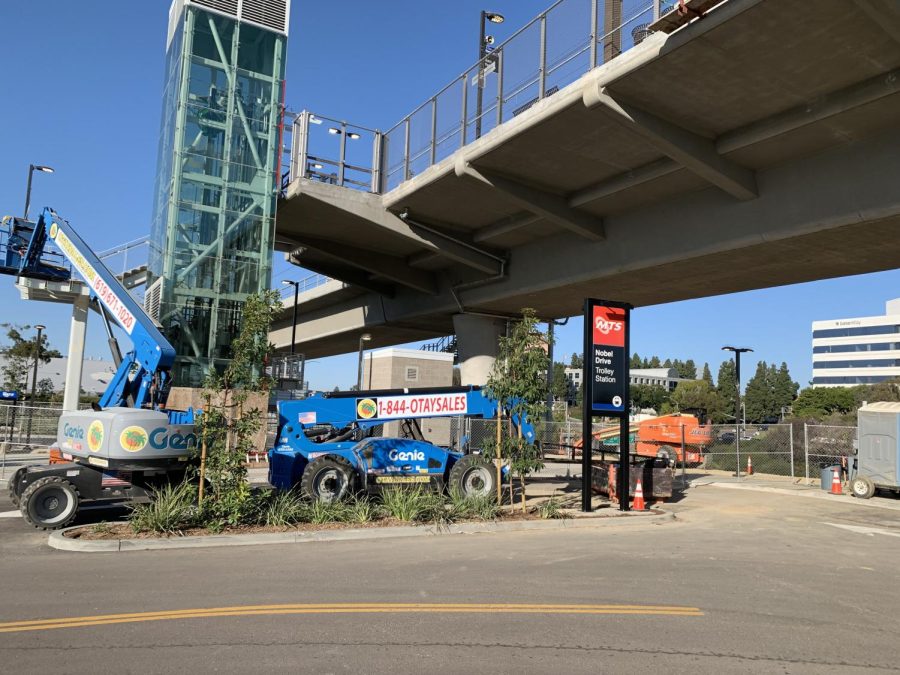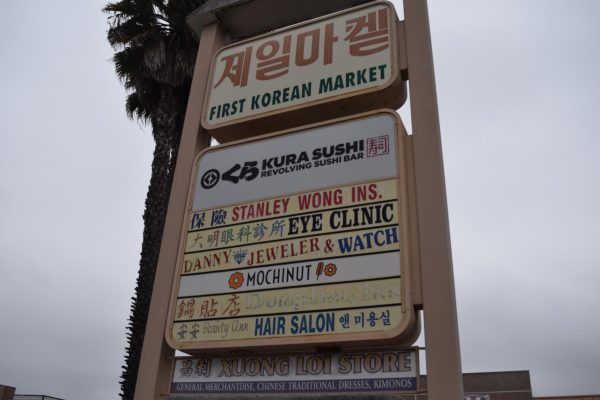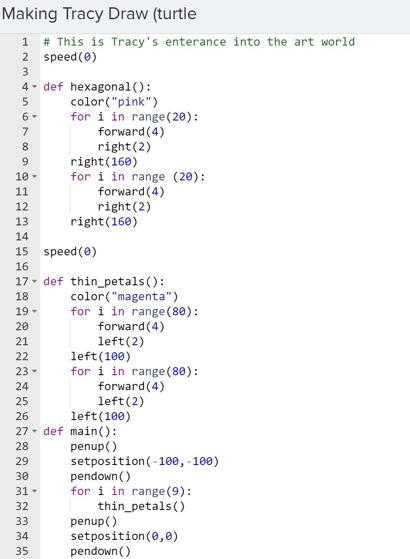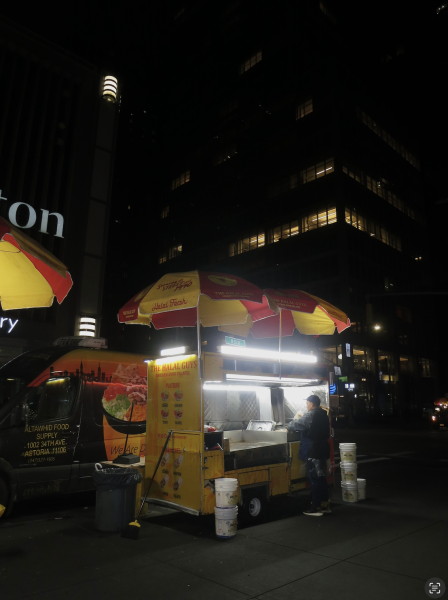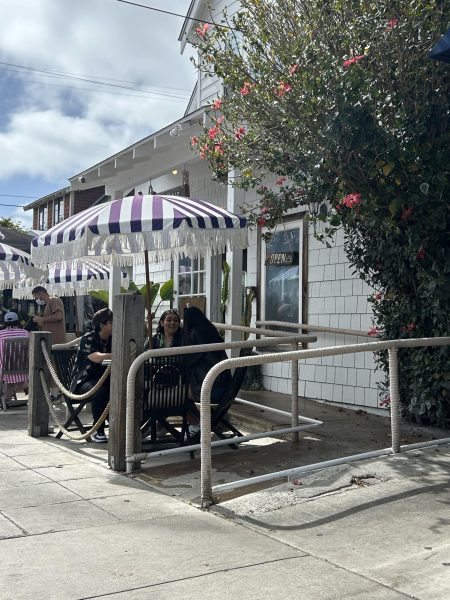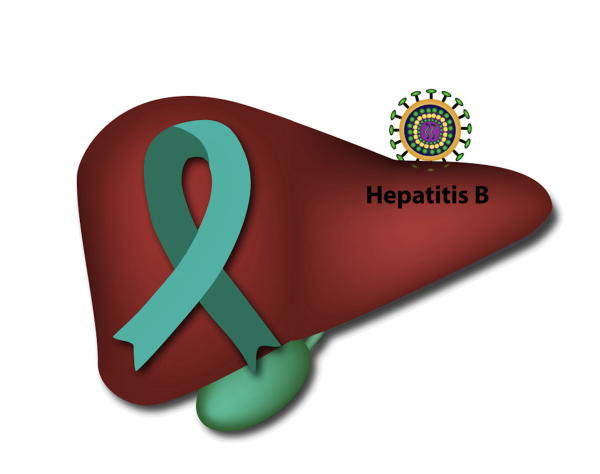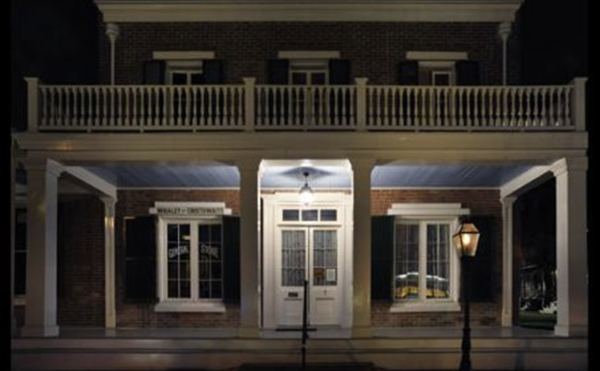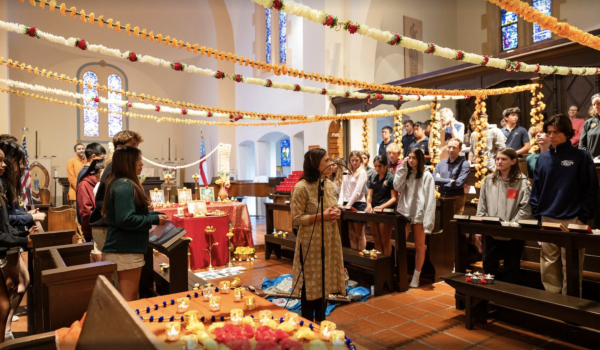Get Riding, PRONTO!
The new trolley and fare system are here
The stations on the trolley extension are close to completion, with ticket machines, benches, and signage being placed in before the November 21 opening.
Step onto a bus, trolley, tram, or train, and you’ll be greeted by an unfamiliar new purple box where the standard yellow Compass Card reader used to be. Walk down La Jolla Village Drive and you’ll be greeted by a massive overhead viaduct and rail stations along the crest of the Interstate 5 corridor. Welcome to the new world of transit here in San Diego.
In La Jolla especially, recent transit changes will alter how we move around and commute in our city. The North County Transit District (NCTD) and Metropolitan Transit System (MTS) have been working on the new trolley and fare card projects for years and they are now being completed and rolled out to passengers across the city.
Mid-Coast Trolley Extension:
The Mid-Coast Trolley Extension has been almost completely constructed, leaving just the finishing touches on the stations to do until the service is completely operational on November 21. The line will extend the Blue Line trolley past America Plaza station to Westfield UTC Shopping Center. From Downtown, it will travel on existing tracks up to Old Town Transit Center, where it will split from the Green Line and continue on a newly constructed route alongside the Interstate 5 corridor.
At many of the newly constructed stops, new parking has been constructed for commuter-based Park and Ride programs, creating 1170 additional parking spaces according to the San Diego Association of Governments (SANDAG). The project started in response to figures which predicted a rise in employment and population in the Mid-Coast region by 12 and 19 percent respectively, also reported by SANDAG.
And the new service translates to some real benefits for our community. “Having this trolley providing access to our South Bay [and] East County communities who can now get [to UTC] by rail rather than by car, it creates a whole level of opportunity that doesn’t currently exist,” said San Diego Mayor Todd Gloria. “That’s one of the reasons why I’ve been a strong supporter of this project for so many years,” he added.
Given that the Blue Line in its current form travels in a North-South direction, the new line will allow commuters to and from La Jolla to reach the South Bay on the same line, as well as East County areas like El Cajon, La Mesa, or Santee on the Orange and Green Lines with a free train transfer. In fact, since the Blue Line already travels to the international border, theoretically, a student would be able to travel from UTC to Mexico for $1.25.
The trolley route travels through the I-5 corridor, therefore bypassing Downtown La Jolla where Bishop’s is located; though, the MTS has a solution. New bus route 140 will start service alongside the opening of the trolley, taking commuters directly from Downtown La Jolla to Balboa Avenue station on the new line, providing access to commuters who wish to travel southbound. Additionally, for commuters from North County who take the Coaster train, the new bus route 979 will open between Executive Drive trolley station and the Sorrento Valley Coaster station.
Students can see the value in having a rail line going down the same roads they use to commute every day, bypassing the normal traffic and traveling at comparable speeds. Soyoon Park (‘22) is excited for the launch of the service because it’ll make getting around much easier. “It seems like the trolley will be an incredibly useful service for students with or without cars. People will be able to get to La Jolla much quicker on the trolley, and it will ease up traffic congestion on the freeways because less people will be using their cars in the area,” she said.
And the connectivity benefits extend far beyond Bishop’s. For example, the Preuss School UCSD focused on allowing low-income students to be the first in their families to graduate from university, has a significant portion of its population in other areas of the city, already reachable by trolley. The stop at UCSD Health is right across from their campus, providing easy access. La Jolla Country Day School also stands to benefit, with their campus being just a short walk from the new Executive Drive station.
The trolley extension is sure to be a welcome addition to the community, connecting the rapidly growing Mid-Coast to the rest of San Diego with high-speed transit. Students without cars will soon have access to a wide range of cost-effective options for transit, and a well-connected network making it feasible to go to La Jolla from either the North or the South.
PRONTO Fare System:
The new PRONTO fare system is a complete overhaul over the previous Compass Card system. Released in May of 2009, the Compass Cards were created to reduce the use of the previous paper passes and to reduce the amount of in-person transactions at customer service centers. Stylized with a yellow background and colorful compass logo, the card was the transit pass of choice for over a decade. Just one simple tap would deduct a one-way fare from your balance or confirm an unlimited ridership pass. However, while the card was an innovative step forward at the time, some serious limitations arose.
For example, the Compass Card stored any pass or cash value on the physical card itself, therefore making it completely card-based. When tapping the card at any station or bus, the card reader would authenticate the card, and then deduct the value of a one-way fare from the storage on the card, rather than a database in the cloud. This meant that it was impossible to buy passes or top up the cash value of the card without visiting a ticket machine or a customer service center and physically updating the card value.
Additionally, the different types of cards, like adult, senior, and youth, were impossible to differentiate between without changing the actual card. So people entitled to reduced fares on transit services like youth (6-18), seniors (65+), disabled people, or Medicare recipients were required to go to a customer service center or participating store to purchase a separate card that matched their reduced fare.
PRONTO, the new fare card and system, stylized with a purple background and big block letters, sets out to provide a more modern solution. Rather than the card-based system on Compass, PRONTO is account- or cloud-based. Cash value of cards are stored on the cloud, allowing someone to add value or a pass from anywhere online. With Compass, the card would transmit fare and balance information to the reader from the card itself, however, PRONTO cards simply transmit their card number to the reader, and the reader then updates the cloud database.
Additionally, the transition to PRONTO means that riders are no longer restricted to using a physical card, which costs two dollars. Now, the PRONTO app is available for download on both iOS and Android, and allows anyone to create a free virtual card on their phone. “The system can be accessed via an app or a physical card with several different ticketing, loading, and account management options that work for everyone including our riders with disabilities or those without access to technology,” said MTS board chair Nathan Fletcher. The card can be used by simply opening the app, and allowing the PRONTO reader to scan the QR code on the homepage.
“Offering a month of free rides and issuing free PRONTO cards helped riders convert to PRONTO and learn about the new system. PRONTO’s features and functionality make riding transit more accessible than ever before,” explained Fletcher.
New benefits for riders come with the use of the technology. Because the system is account-based, a card can be changed to one with discounted fares by simply requesting online or over the phone. Additionally, the new card operates on a “Best Fare” principle, which means that one-way fares will be deducted from the card balance until reaching the equivalent price of a day or month pass. After reaching the equivalent price, the card reaches its fare cap, and then all subsequent rides for the day or month have no charge. Also, the PRONTO card allows for unlimited transfers on all MTS and NCTD services, excluding the heavy rail Coaster, if transferring within two hours of the initial tap.
But whether it’s the PRONTO cards or Blue Line trolley, there are new ways to get riding in San Diego. Every 15 minutes, a bus or trolley rolls by the stop, picking up passengers headed all around our city. Will you be one of them?

Kyle Berlage joined The Tower as a freshman in 2018. Was he a terror then? Yes, but so were others on staff. After all, if all your friends jump off a...


